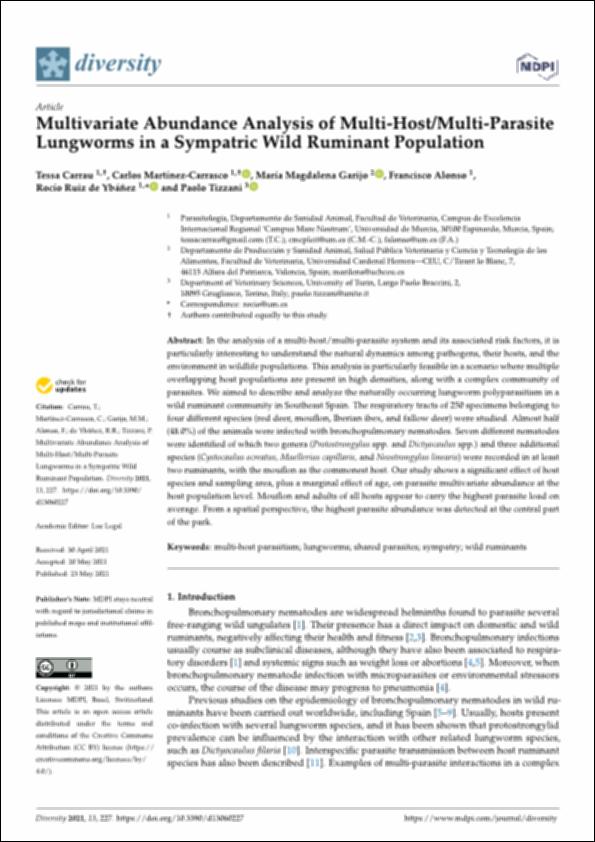Please use this identifier to cite or link to this item:
http://hdl.handle.net/10637/13474Multivariate abundance analysis of multi-host-multi-parasite lungworms in a sympatric wild ruminant population
| Title: | Multivariate abundance analysis of multi-host-multi-parasite lungworms in a sympatric wild ruminant population |
| Authors : | Carrau Garreta, Tessa Martínez Carrasco, Carlos Garijo Toledo, María Magdalena Alonso, Francisco Ruiz de Ybáñez, María Rocío Tizzani, Paolo |
| Keywords: | Rumiantes - Enfermedades parasitarias.; Helminthiasis in ruminants.; Ruminants - Parasites.; Rumiantes - Aparato respiratorio - Enfermedades.; Ruminants - Respiratory organs - Diseases.; Rumiantes - Parásitos. |
| Publisher: | MDPI |
| Citation: | Carrau, T., Martínez-Carrasco, C., Garijo, M.M., Alonso, F., de Ybáñez, R.R. & Tizzani, P. (2021). Multivariate abundance analysis of multi-host/multi-parasite lungworms in a sympatric wild ruminant population. Diversity, vol. 13, i. 6 (23 may.), art. 227. DOI: https://doi.org/10.3390/d13060227 |
| Abstract: | In the analysis of a multi-host/multi-parasite system and its associated risk factors, it is particularly interesting to understand the natural dynamics among pathogens, their hosts, and the environment in wildlife populations. This analysis is particularly feasible in a scenario where multiple overlapping host populations are present in high densities, along with a complex community of parasites. We aimed to describe and analyze the naturally occurring lungworm polyparasitism in a wild ruminant community in Southeast Spain. The respiratory tracts of 250 specimens belonging to four different species (red deer, mouflon, Iberian ibex, and fallow deer) were studied. Almost half (48.0%) of the animals were infected with bronchopulmonary nematodes. Seven different nematodes were identified of which two genera (Protostrongylus spp. and Dictyocaulus spp.) and three additional species (Cystocaulus ocreatus, Muellerius capillaris, and Neostrongylus linearis) were recorded in at least two ruminants, with the mouflon as the commonest host. Our study shows a significant effect of host species and sampling area, plus a marginal effect of age, on parasite multivariate abundance at the host population level. Mouflon and adults of all hosts appear to carry the highest parasite load on average. From a spatial perspective, the highest parasite abundance was detected at the central part of the park. |
| Description: | Este artículo se encuentra disponible en la siguiente URL: https://www.mdpi.com/1424-2818/13/6/227 |
| URI: | http://hdl.handle.net/10637/13474 |
| Rights : | http://creativecommons.org/licenses/by/4.0/deed.es |
| ISSN: | 1424-2818 (Electrónico) |
| Issue Date: | 13-May-2021 |
| Center : | Universidad Cardenal Herrera-CEU |
| Appears in Collections: | Dpto. Producción y Sanidad Animal, Salud Pública Veterinaria y Ciencia y Tecnología de los Alimentos |
Items in DSpace are protected by copyright, with all rights reserved, unless otherwise indicated.


